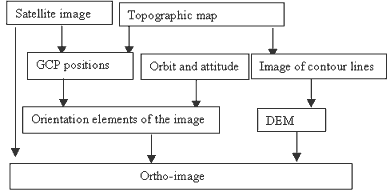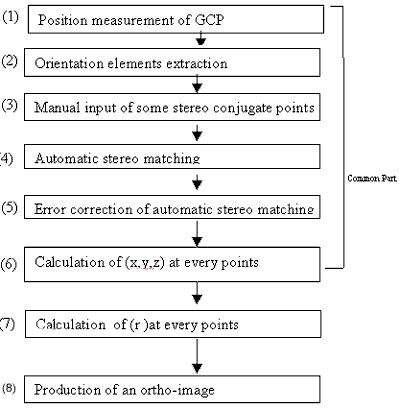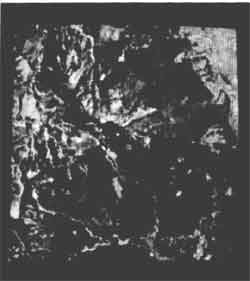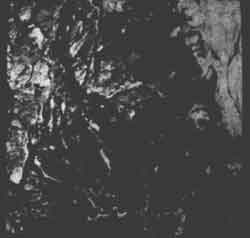| GISdevelopment.net ---> AARS ---> ACRS 1997 ---> Digital Image Processing |
An ortho-image production
method from stereoscopic images
Nobuhiko Mori
Osaka Institute of technology
1-79-1, Kitayama, Hirakatashi, Osaka, 573-01, Japan
Tel : (81)-720-66-5390 Fax : (81)-720-66-8380
Email :nmori@ij.oit.ac.jp
Abstract
Osaka Institute of technology
1-79-1, Kitayama, Hirakatashi, Osaka, 573-01, Japan
Tel : (81)-720-66-5390 Fax : (81)-720-66-8380
Email :nmori@ij.oit.ac.jp
An ortho-image is usually made using both an image and a DEM (Digital Elevation Model) of the same area. In this paper, a new method is proposed, which produce an ortho-image from streoscopic images directly. Because two images of the same are used in this method, some image corrections, such as partial replacements and arithmetical calculations on images, can be carried out to make a fine output of an ortho-image. This method can be realized by modifying the software of a digital photogrammetric system slightly.
1. Introduction
It is well known that ortho-images are necessary to make stereoscopic images of any B/H ratio, or bird's eye view images from any view point. But nowadays they are more frequently used in GIS (Geographic Information System), because they can be overlaid directly on many kinds of maps in the system. Ortho-images are usually made using DEMs and images with orientation elements. Because there are few kinds of available DEMs now, those DEMs are very often extracted with appropriate interval from topographic maps with contour lines or stereoscopic images. There are many proposed methods to extract DEMs from contour lines automatically by computer. When stereoscopic images are used, DEMs are extracted by using digital photogrammetric system. It is a very cumbersome work to make an ortho-image, because there are two steps in the work, a DEM extraction and an ortho-image production.
2. An example of an ortho-image production method using a DEM
An ortho-image is usually made from an image with orientation elements using a DEM. Figure 1 shows a common procedure to make an ortho-image using a DEM. In this case, a satellite image, such as SPOT or JERS, is changes into an ortho-image. In this figure, a DEM is extracted from contour lines of topographic maps. Orientation elements of the satellite images are determined using GCP (Ground Control Point) positions on both the satellite image and topographic maps. Data of orbit and attitude of the satellite is used in the extraction of the orientation elements are determined as the functions of time. The output ortho-image is made using the input satellite image, the orientation elements and the DEM. Photo 2 is an example of the output made by this method. The input image is a SPOT image of Hishikari District in Japan.

Figure 1 A method for making an ortho-image using a DEM

Photo 2 An ortho-image of the Hishikari district in Japan
3. An ortho- image production method from stereoscopic images
As mentioned above, a DEM is necessary to make an ortho-image by conventional methods. But in the case of a digital photogrammetric system, it is possible to make an ortho-image from stereoscopic images directly. In addition to the ability to extract a DEM from stereoscopic images, the digital photogrammetric can produce an ortho-image also from the same stereoscopic images. Figure 3 shows the method to make an ortho-image directly. In the figure, the left and the right image compose a pair of stereoscopic images, and are placed on the position where the images were taken. O' is the perspective center of the left image, and O' is the one of the right image. These positions of the left image, O', the right image and O' can be determined by doing orientations of the both images. P is a point on an object. P' is the corresponding point of the P on the left image, and P" is one on the right image. The position of P can be determined as the cross point of two lines, O'P' and O"P". The pixel values of P' and P" are r' and r", respectively. The radiance of P, which is represented by r, is the function of r' and r".

Figure 3: The method for making an ortho-image using steroscopic images
Many kinds of formula can be used as f, and r can be calculated from r' and r". An ortho-image of the object is obtained by calculating the values of r of all Points on the object. As two input images are used to make an ortho-image in this method, it is possible to make some image corrections, such as partial replacements and arithmetical calculations on images, to make a fine out put of an ortho-image.
4. An ortho- image production system from stereoscopic images
The method to make an ortho- image from stereoscopic images can be realized on a digital photogrammetric system . In this research ,PC - based digital phtogrammetric system with 3D display has been used. This ortho-image production method has been realized by changing the DEM extraction software a little. Figure 4 is the flow chart of the ortho-image production software developed on the system. The common part with the DEM extraction software is indicated in the figure 4. A brief explanation of the figure is given as follows.

Figure 4 The flow chart of the ortho-image production software
- Positions of GCPs are measured in both images and maps.
- Orientation elements of both images are extracted.
- Positions of some stereo conjugate points are inputted manually as initial conditions.
- Sufficient number of stereo conjugate points are determined by stereo matching.
- Errors of automatically determined stereo conjugate points are corrected.
- Positions of object points are calculated from those of stereo conjugate points.
- The radiances of objects points are calculated from the values of stereo conjugate points.
- An ortho-image is produced using a resampling program.
- Because the pixel positions of the ortho-image and the data positions of the DEM are completely the same, it is very easy to make bird's eye view images or stereoscopic images of any B/H ratio from these data.
- The accuracy of pixel positions of the ortho-image in this case is better than in the usual case using a DEM, because it is necessary in the usual to resampling to make an arrayed DEM from irregularly positioned height data.
An ortho-image production experiment by the system mentioned above was carried out. Two SPOT panchromatic images of different dates at Mr. Minobu near Mr. Fuji in Japna were used as the input stereoscopic images. Photo 5 is the left image at Mt. Minobu. Photo 6 is the right image at the same place. Photo 7 is the output ortho-image made from these stereoscopic images by the system. Since the two input images are very similar in this case, the pixel values of the output ortho-image were determined using only the right image pixel values.

Photo 5 The left image at Mt. Minobu Date : 1988. 3.7 Off-nadir angle: 4.1 deg. East

Photo 6 The right image at Mt. Minobu Data : 1988. 3.8 Off-nadir angle: 23.8 deg. West

Photo 7 The output ortho - image at Mt. Minobu
6. Conclusion
Using a digital photogrammetric system, an ortho-image can be made without DEMs. In this case, an ortho-image is made from stereoscopic images directly. This ortho-image production software can be developed on a digital photogrammetric system by modifying DEM extraction software slightly. The accuracy of pixel positions of an ortho-image in this case is better than in the usual case using a DEM, because a DEM included slight error when it was arrayed by resampling. Using this system, it is very easy to make bird's eye view images or stereoscopic images of any B/H ratio, because both an ortho-image and a DEM can be obtained at the same. Concerning the radiance, as the pixel values of an output ortho-image can be calculated using those of two input images in this system, some image corrections, such as partial replacements and images in this system, some image corrections, such as partial replacements and arithmetical calculations on two input images, can be carried out to make a fine output of an ortho-image. It is a future problem to develop such a method as calculating precise pixel values of an output ortho-image from two input images.
References
- N.Mori, S.Masuda, S.Murai, 1992; Development of a PC-Based Digital Photogrammetric System; ISPRS, Washington, 29-B2-2, pp.319-322
- N.Mori, 1995; Development of a Stereoscopic Image Processing Software; ACRS, Nakhon Ratchasima, Thailand, pp.S.6.1-S.6.6.
- N.MORI, S.Murai, 1996; Stereoscopic Image Processing Using a Digital Photogrammetric System; ISPRS, Vienna, 31-B2-2, pp.266-271.